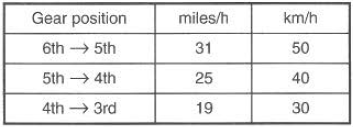Suzuki GSX-R 1000 Owners Manual: Using the transmission
The transmission is provided to keep the engine operating smoothly in its normal operating speed range. The gear ratios have been carefully chosen to meet the characteristics of the engine. The rider should always select the most suitable gear for the prevailing conditions. Never slip the clutch to control road speed, but rather downshift to allow the engine to run within its normal operational range. The table below shows the approximate speed range for each gear.
Shifting up schedule

Shifting down schedule

Disengage the clutch when the motorcycle speed drops below 12 miles/h (20 km/h).
 Warning Warning
Reduce speed before downshifting. |
 Warning Warning
Reduce your speed and downshift before entering the corner. |
|
Caution Revving the engine into the red zone can cause severe engine damage. Never allow the engine to rev into the red zone in any gear. |
 Starting off
Starting off
Warning
Riding this motorcycle at
excessive speed increases
your chances of losing control
of the motorcycle. This may
result in an accident.
Always ride within the limits of
...
 Riding on hills
Riding on hills
When climbing steep hills, the
motorcycle may begin to slow
down and show lack of power.
At this point you should shift to
a lower gear so that the engine
will again be operating in its
...
Other materials:
Side stand
An interlock switch is provided to
cut off the ignition circuit when the
side stand is down and the transmission
is in any gear other than
neutral.
The side stand/ignition interlock
switch works as follows:
if the side stand is down and
the transmission is in gear, the
engine ...
Pillion footrest construction
Pillion footrest
Spring
Ball
E-ring
Washer
O-ring
Footrest pin
Apply grease.
Do not reuse.
...
Specifications
Tightening torque specifications
Note
the specified tightening torque is described in the following.
“Rear view mirror construction”
Reference: for the tightening torque of fastener not specified in this
section, refer to “tightening torque list” in section 0c . ...
